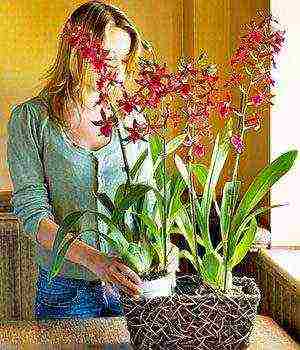Content
A round pearl with a smooth surface is a rare piece that is worth its weight in gold.
Natural pearls
is formed in the shells of molluscs living on the seabed, and the growth process requires several years of calm and a nourishing environment.
How pearls are formed
The secret of the appearance of spherical nacreous inclusions inside the shell of a mollusk is simple: a grain of sand, a fragment, a parasite larva, a pebble or other small particle that the mollusk recognizes as a foreign body gets there through the slightly open valves. To neutralize the alien, he uses mother-of-pearl, evenly covering the irritant with this hardening substance.
Growing pearls at home is impossible. For growth, immersion in the sea is required, the water of which is rich in trace elements necessary for the healthy life of the mollusk.
It takes months and even years to form a round pearly body. Due to the immobility of the mollusk, pearls are often uneven.
Pearl growing methods
Thanks to human observation, the principle of pearl cultivation was discovered in antiquity. Over the years, inventive personalities have added interesting nuances to the traditional solution, but the essence remains the same: a foreign body is placed inside the shell of the mollusk, around which it forms a mother-of-pearl shell.
Chinese way
The first to grow cultured pearls were the Chinese. Back in the 13th century, they invented a simple procedure:
- The shell of a young mollusk is opened with fine forceps.
- Inside, between the folds of the mollusk mantle, a grain of sand is laid with a bamboo stick and the valves are closed.
- The finished shell is placed in a special enclosure in the sea and waited for a couple of years.
China is a leader in the production of pearls. Farmers grow their crops in fresh water. Chinese pearls are rarely used for jewelry: they are crushed into powder, which is added to cosmetics and medicine.
Swedish way
In the 18th century, the Chinese procedure was improved and supplemented by the naturalist Linnaeus, who later grew many of the most valuable specimens.
For a long time, the scientist failed to create round pearls, and then he invented a solution: with a thin drill he made a hole in the upper shell of the shell and lowered a wire with a limestone ball at the end into it.
As it grew, it was supposed to twist and move the ball so that the mother of pearl was applied evenly. In view of the troublesome method invented by Linnaeus, he did not make an impression and was soon forgotten.
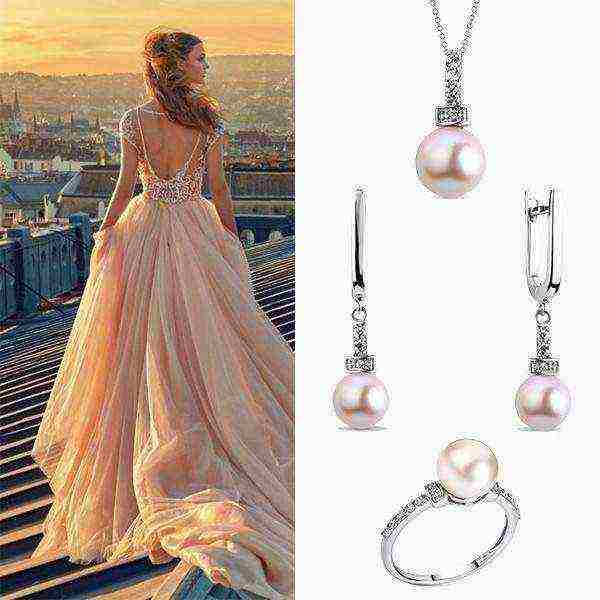
Silver pendant with pearls and cubic zirkonia, SL; silver earrings with pearls and cubic zirkonia, SL; silver ring with pearls and cubic zirkonia, SL (prices by links)
Japanese way
In the 19th century in Japan, pearl cultivation took on an industrial scale.
To speed up and simplify the procedure, the Japanese attached a ready-made small pearl ball to the mother-of-pearl flap, and then lowered the shell into sea water along with the rest, placing them in special wooden structures designed to protect the mollusks from predators.
Japanese pearls have a flat surface on the side where they were attached to the mother-of-pearl layer, therefore, when processing, a mother-of-pearl patch is attached to the flat side of the pearl. This feature is the hallmark of cultured Japanese pearls.
Pearls are a valuable commodity used in many sectors of the economy.It is known to some as a valuable jewelry insert in rings, bracelets, necklaces or pearl beads. Also, pearls are used in medicine, it has healing properties for certain diseases. It is often used as a special powder. Still, you can achieve the highest income by selling quality minerals to jewelry companies.
Pearl pearl.jpg (124.56 KB) 2011 views Pearl is a complete mineral, but it is not entirely natural in origin. It is customary to call pearls a mineral of the class of organic compounds and they are strong. Pearls literally originate in some types of molluscs after any foreign body gets there. It can be a large stone or a small grain of sand.
After a grain of sand enters the living organism of the mollusk, a special process begins. Humanly, it could be called "interception", since the mollusk will try to prevent injuries to its ecosystem and neutralize all the harm from a foreign object.
Therefore, around the object itself, the mollusk begins to form safe and not sharp deposits of nacre. They are applied almost evenly and for a long time. The shape of the final pearl depends on the very foreign object, if the grain of sand was oval, then the pearl will be oval.
Mass release For mass production, you need to grow small mollusks and open the "disc" for them in order to shove a grain of sand of an ideal shape inside with a small tool. Many people use regular grains of sand, as you can achieve rounded shapes by adding a simple round stone.
Unfortunately, even a perfectly flat stone does not guarantee that pure and rounded pearls will be formed from it. Even the color can be different, this is influenced by the water and the age of the mollusks. Therefore, you need to put everything on stream and try to increase the level of pure jewelry pearls.
Sometimes, by inserting a perfectly rounded probe, you can get crooked pearls. The fact is that pearl oysters rarely, but open for different purposes, and at this moment they can accidentally get another grain of sand, spoiling the first one.
Organization To begin with, you can try to buy such a pearl mussel in exotic countries, in the same Thailand. After that, the experiment should be carried out with the understanding that this is a painstaking and long process. After all, to get a pearl of any kind, you need to wait at least 3 years. And most importantly, not every pearl oyster will be able to grow pearls, since she may have internal problems.
Natural conditions: a simple pool should be organized for several dozen molluscs in separate sectors. At the same time, 20-40 mollusks for one such mini-pool may be enough. Next, you need to throw grains of sand or special small beads into them and control the reservoir for about 2 years. After transplanting small mollusks into larger trays, where after a year of life, you can harvest.
Artificial conditions: using the latest technology, it is possible to accelerate the pearl production process, which is difficult to achieve through cultivation. It is much easier for an ordinary person to work with conventional technologies.
The third option: You can simply put the mollusks in special cages and throw them into their natural environment. To prevent them from escaping, they must be inside the cages.
The work is difficult, since in 3 years you will receive only small pearls, for large sizes you need to wait longer. And getting a non-freezing lake in the Russian Federation is difficult. But for the purpose of self-development, you can buy yourself such a mollusk and in 10 years get a good pension. After all, several dozen pearls can grow inside each mollusk.
Pearl It is a rounded solid formation that is extracted from the shells of some molluscs and is classified as a mineral of the class of organic compounds. Pearls are highly prized and used in jewelry making.
As a result of a foreign object, such as a grain of sand, entering the shell of a mollusk, a pearl is formed inside it. Then, around the seed, nacre is deposited, which forms concentric circles in thin films.
The resulting mother of pearl is an organomineral aggregate of calcium carbonate and conchiolin. However, in this case, the mineral and organic components of pearls do not come into contact with each other.
Pearls are classified according to their place of origin, so they can be marine and freshwater. Besides, according to the method of origin, natural and cultured pearls are distinguished.
Play of light on pearls, its brilliance is due to the interference of light on a wavy surface. Usually pearls are colored white, cream or pink. There are also green, black, yellow and blue pearls. Blue pearls are highly prized for their rare lead-gray hue.
Since the beginning of the twentieth century, natural pearls have been mined, as well as pearl cultivation on an industrial scale.
Growing pearls at home consists in placing beads from pressed shells inside the pearl oyster, after which the mollusks are returned back to the water. After a while, the beads covered with multiple layers of mother-of-pearl are removed.
How to grow pearls can be learned from various literature. The process of obtaining cultured pearls consists in creating specific artificial conditions, as well as introducing an irritant that provokes the oyster to secrete nacre.
There are many ways to obtain cultured pearls. This can be the oyster transplant method, the nuclear-free method, or using the central nucleus.
Pearl growing business began in 1893 when Kokichi Mikimoto received a patent for pearls. This technology is still used today. A nacreous ball, which is obtained from the tissue of another mollusk, is planted in the mollusk.
After the operation, it is returned to a natural reservoir, where cultivation continues. Such pearls do not have any artificial inclusions and are called Japanese or nuclear-free.
New cultivation techniques are used to grow near-perfect pearls. Therefore, only highly qualified specialists using special equipment can distinguish between natural and artificial pearls.
The pearl growing process is time consuming and laborious. Only one quarter of shellfish are able to grow pearls in favorable conditions. Cultivation begins with the collection of pearl oyster eggs and then they are grown in special incubators.
Oysters grown from eggs are placed in cages with small cells, this protects them from other inhabitants, and are released into natural conditions.
Divers periodically clean their cages and check the condition of the pearl molluscs. After 2 years, the grown oysters are moved into large cells, and after three years, mother-of-pearl balls are placed in the matured oysters.
Modern improvements to the method allow the introduction of an antibiotic so that bacteria do not interfere with the development of the nucleus. Up to 20 pearls can be grown in one shell at a time.
Pearl cultivation is very profitable, despite all the complexity, oyster farms can bring significant profits to their owners.
Pearls are one of the few gems of organic origin. Handsome, but vulnerable, sensitive to external stimuli. However, it is not difficult to care for pearls at home. Natural and cultivated material do not differ in this sense.
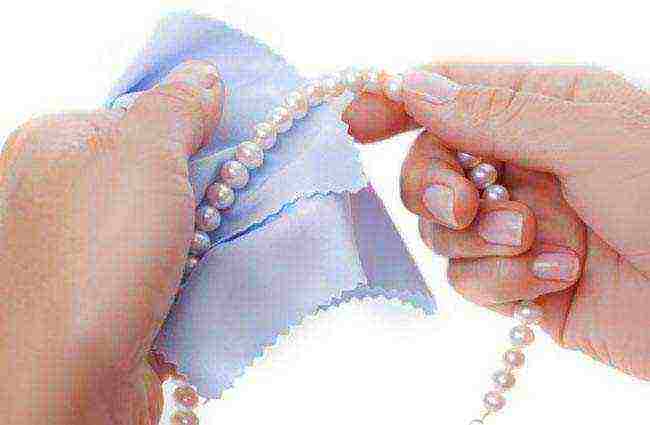
How to store pearls
Pearls that are natural or farmed are fragile and must be stored properly.
Microclimate
It is created without problems by air conditioning, but this is not always possible. Owners of pearl jewelry should comply with the following conditions whenever possible.
- Humidity.The air in the room should not be dry, otherwise the pearl will begin to dehydrate and the aragonite will flake off. But if there is a lot of moisture, the stones will become cloudy. To make the humidity level optimal, on a hot day or during the heating season, a container with water is placed near the box.
- Temperature. You need an average one - the stones will crack from the heat, they will become cloudy from the cold.
- The sun. The mineral is afraid of direct sunlight. Prolonged exposure to the sun makes the stones dull, yellowish.
- Dust. From it, microcracks appear on the surface of the pearls.
- Tobacco smoke. A room where people smoke is contraindicated for pearls. He dies from tobacco smoke.
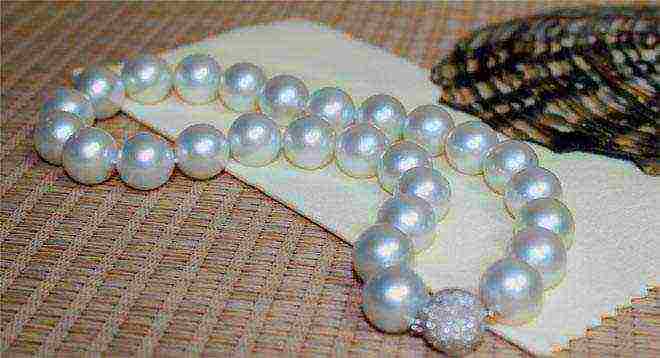
If the jewelry is rarely worn, it is rubbed with velvet from time to time. This way the pearlescent shine is preserved.
Storage
As a container, a plastic bag or other sealed packaging is excluded - they prevent the penetration of moisture, because of which the pearls suffocate, and the mother of pearl tarnishes. A fabric bag is also not suitable - here the pearls will wear out.
A place that ideally meets all the requirements for storing pearls is a casket. She must be:
- durable to exclude external influences;
- spacious, where even a large necklace will fit freely, and the clasps do not touch the beads;
- closed tightly to obstruct dust or light;
- lined with soft natural material.
There is no place for other jewels in it. She is also the best solution when transporting stones.
How and how to clean pearls
While wearing jewelry, pearls and frames get dirty. There are simple ways to clean your jewelry.
General principles
They are used regardless of the type of pearls, the material of the frame, the degree of pollution:
- use a soft cloth or sponge;
- wash with filtered warm water (chlorinated or hot water will destroy stones);
- folk remedies such as ammonia, vinegar, hydrogen peroxide, and other aggressive and abrasive compounds are excluded;
- dry at room temperature.
The washed jewelry is returned to the box after drying.
Methods and means of cleaning
At home, you can clean pearls with hand tools:
- Baby soap or mild shampoo. Jewelry such as rings or earrings is dipped in the solution for a quarter of an hour, then wiped dry. A necklace or bracelet is washed differently. Each pearl is wiped with a damp cotton swab. Remove soap residues with a clean, damp cloth. Dry on a soft cloth.
- Potato starch. It is used in problem cases, if other methods have proved to be useless. Beads are rubbed with velvet cloth, on which starch is poured. Excess moisture is removed with dirt.
- Special paste. Apply to soft fabric. Each bead is wiped and polished with a dry, lint-free cloth.
The last method is the easiest and most reliable, but it is applicable conditionally. The paste is not sold everywhere, and the method is not suitable for frequent use. The pearls will shine again, but the cleaning components of the paste will shorten their lifespan.
The return of shine
Jewelry with pearl inlays fades. Shine and shine are brought back in several ways:
- Olive oil. It is the olive of a high degree of purity that is safe. A few drops are applied to a cotton swab with which the pearls are rubbed. The remaining oil is removed with a paper towel.
- Sunbathing. Prolonged exposure to direct sunlight is detrimental to pearls, but sessions for a couple of hours can whiten them. After the procedure, the beads are wrapped in a cloth. Sometimes a series of sunbathing is required. It is important to observe natural pearls to avoid overheating.
- Sea water. Placed for several hours in a container with sea water. It is obtained by dissolving sea salt in water (from a supermarket or pharmacy). Any water, including tap water.
You can use a special paste, but this is an extreme case, since it abrades the pearls.
How to wear pearls
The worst natural pearls get dirty and deformed when using, that is, wearing jewelry. It is useful to know how to wear jewelry correctly.
- Pearls absorb various substances. Therefore, rule number one is to wear jewelry when cosmetics and perfumes are applied and absorbed.
- Pearls are not worn on the beach or for a walk in the hot dazzling sun - they will crack.
- The mineral does not like home chemistry, greasy fumes. Decorations are removed for homework or cooking.
- Chlorinated water is detrimental to the material. Therefore, jewelry is not taken to the bathroom, pool, sauna.
- It is better to wear pearl accessories on the body or delicate fabrics such as silk. Friction against a fleecy or textured surface leads to abrasion of the mother-of-pearl.
- After going out, the first thing to do is to remove the jewels. Rinse with clean (preferably filtered) water to remove dust, cosmetics residues, and other micro-dirt. Wipe with a soft napkin, put in a box.
- When removing a necklace or choker, they take a metal clasp, not beads.
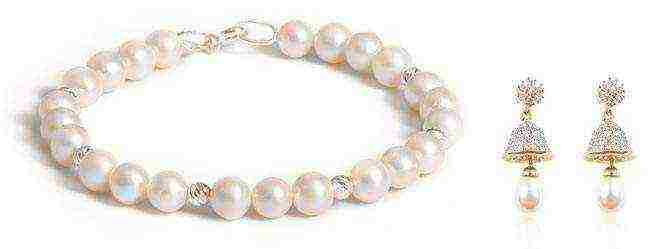
In order for your favorite beads or other pearl beauty to remain "young" for a long time, you need to wear it. Long imprisonment in the box will make it dull. And the skin's moisture absorbed by the mineral adds radiance.
Special cases
Pearl care in some types of jewelry has nuances.
Framed products
Before cleaning, it is advisable to remove the pearls from the setting and clean the metal frame and beads separately. But this is not always possible.
Gold
Gold earrings or other jewelry is washed with a solution of baby soap with a soft brush and dried. The metal is cleaned with a cotton swab dipped in cologne. Make sure that the product (or other special compositions for gold) does not get on the pearls.
Silver
The decoration is washed with a weak solution of baby soap with a cotton swab or soft napkin. Pearls and silver do not like long bathing, so the product is cleaned and rinsed quickly. Dry with a soft cloth.
For heavily darkened silver, a special procedure is arranged. The decoration is placed in a bag or on a regular fabric, the ends of which are tied with a knapsack. Sprinkle generously with salt, dipped in water. Rinse until the salt dissolves. Pearls shimmer again, silver glitters.
Beads and necklace
To take care of the beads correctly, you need to consider the following:
- When buying, it is better to prefer a product with beads separated by thread knots. This insulates each bead, reducing abrasion.
- The thread on which the pearls are collected is gradually stretched and frayed. Dirt accumulates on it between the beads, which can damage them from the inside. Therefore, the thread is changed after two to four years, depending on the degree of use.
- When stringing beads on a new thread, it is advisable to make knots between them, as on the old one. The best thread for pearls is silk. It is delicate, does not stretch well, and reluctantly absorbs extraneous components.
- The necklace or beads are stored and dried in a horizontal position so that the thread does not stretch.

If you are unsure of your abilities, entrust the renovation of the necklace to the master. Saving on precious natural pearls is inappropriate.
Artificial material care
The above applies to expensive natural or cultured material. Popular artificial pearls are more affordable.
It is less demanding and troublesome to care for. Less responsive to humidity, temperature, sun. But there are limitations, since it is performed using natural materials. Even the cheap "Roman" beads are covered with pearl essence, and the expensive "Majorca" is almost entirely made of mother-of-pearl.
The material is provided with a protective coating, but it is not omnipotent. Therefore, you should not experiment with acids, extreme temperatures, aggressive household chemicals. The pearl finish will come off, leaving an unsightly base.
It is advisable to attach a separate box to the products, to protect them from contact with sharp objects.
When buying natural or cultured pearls, you need to be aware that there is not enough standard care. But something beyond is not required either. For cleaning, there are enough tools at hand.
The mineral loves to be contacted with, communicate, walk in the sun. If you are not expected to go out, beads or a ring can be worn at home for a couple of hours. It will cheer you up, strengthen your self-esteem, and nourish the precious gem.
